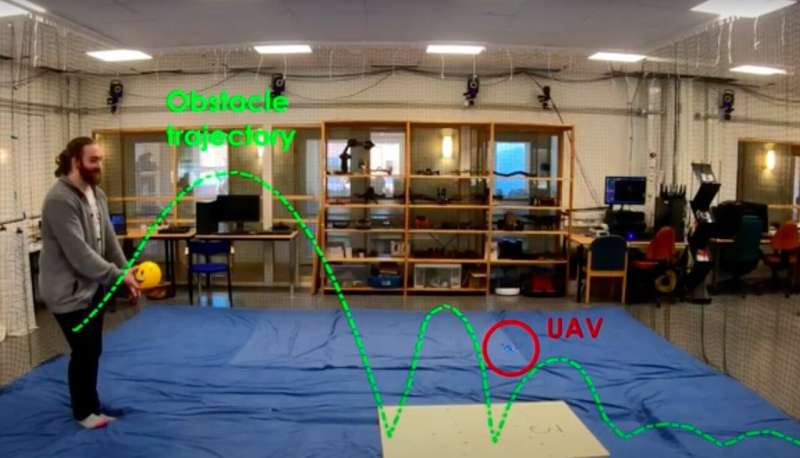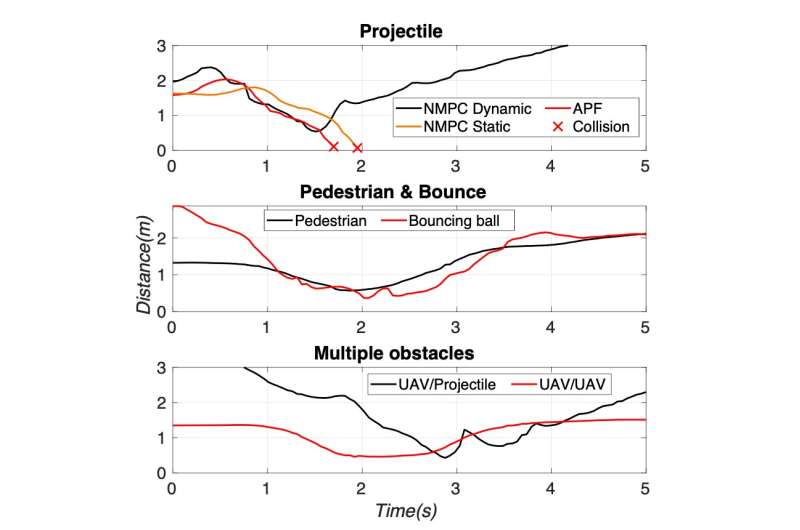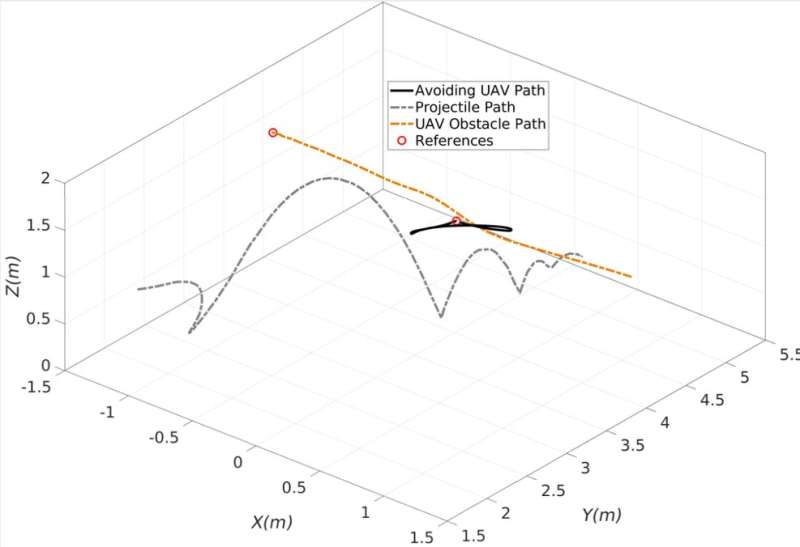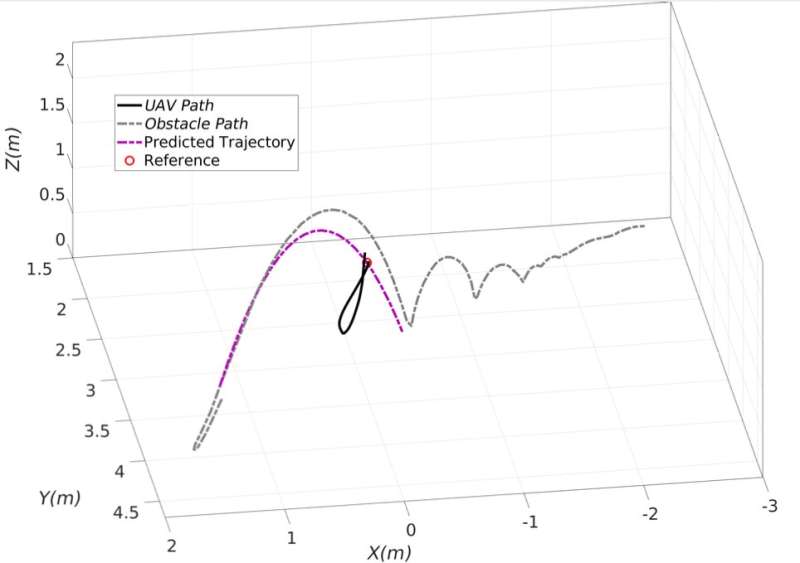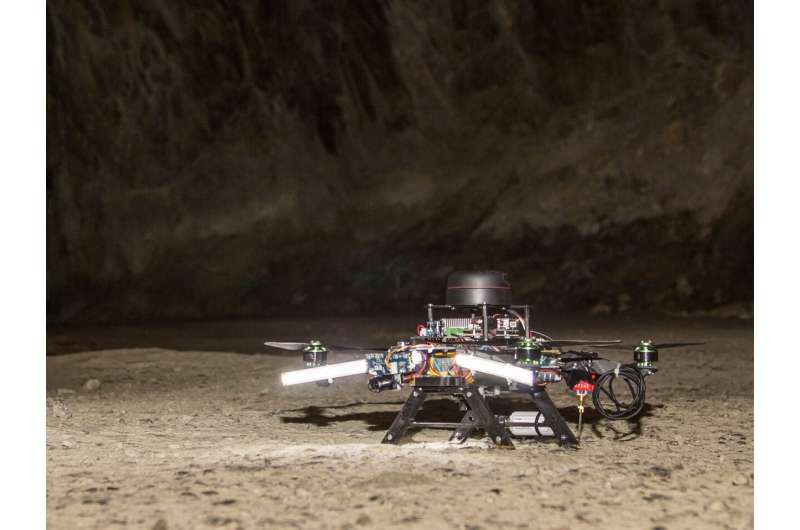Screenshot from a video of the experiments carried out by the researcher. Credit: Lindqvist et al.
Autonomous unmanned aerial vehicles (UAVs) have shown great potential for a wide range of applications, including automated package delivery and the monitoring of large geographical areas. To complete missions in real-world environments, however, UAVs need to be able to navigate efficiently and avoid obstacles in their surroundings.
Researchers at Luleå University of Technology in Sweden and California Institute of Technology have recently developed a nonlinear model predictive control (NMPC)-based computational technique that could provide UAVs with better navigation and obstacle avoidance capabilities. The NMPC approach they used, presented in a paper published in IEEE Robotics and Automation Letters, is based on the structure of OpEn (Optimization Engine), a parametric optimization software developed by Dr. Pantelis Sopasakis at Queen's University Belfast.
"Our team has previously published several works on autonomous obstacle avoidance and navigation for UAVs," Björn Lindqvist, one of the researchers who carried out the study, told TechXplore. "In our recent study, we set out to extend the notion of obstacle avoidance to include a direct consideration of moving or dynamic obstacles, using NMPC. Our objective was to offer a technical demonstration of how modern and intelligent control structures could allow UAVs to be used in, for example, urban environments where the surroundings are always moving and where collision avoidance is of great importance to ensure the safety of persons and other vehicles."
Credit: Lindqvist et al.
NMPC is an optimization-based scheme that can be used to solve a variety of real-world problems. This scheme can make predictions about future states of a system based on a mathematical model of the system and on a series of control inputs acting on it at a given time.
Its predictions cover a number of future time steps, which combined are referred to as the 'prediction horizon." Subsequently, the scheme computes the control inputs in ways that allow a system to complete a set of desired objectives most effectively (e.g., reference tracking, avoiding obstacles, maintaining constraints, etc.).
In their paper, Lindqvist and his colleagues showed that an NMPC-based model could provide UAVs with advanced autonomous navigation and obstacle avoidance capabilities in changing environments, such as cities. More specifically, they used an NMPC algorithm to predict the trajectories of obstacles in a UAV's surroundings, while also employing a classification model to differentiate between different types of trajectories and predict the future position of obstacles.
"As NMPC works by predicting and optimizing over future states, we can incorporate the direct consideration of moving/dynamic obstacles by predicting their future positions, as well, based on some measurements," Lindqvist said. "This method allows for an elegant solution where control, local path planning and dynamic obstacle avoidance are incorporated in one control layer."
Credit: Lindqvist et al.
The researchers evaluated their NMPC scheme in a number of laboratory experiments. Remarkably, their model prevented collisions in a variety of scenarios in which a UAV was surrounded by multiple moving obstacles.
"At the Robotics & AI Team at Luleå University of Technology we place a very high value on experimental validation of theory," Lindqvist said. "In our recent work, we showed how a NMPC architecture can provide collision-free trajectories even for quite quickly moving obstacles, without violating the specified safety distances. I believe that this type of obstacle avoidance is an interesting path toward using UAVs in urban environments or in close interaction with humans."
Credit: Lindqvist et al.
The study highlights the great potential of NMPC optimization schemes for enhancing the navigation capabilities of UAVs. The findings gathered by Lindqvist and his colleagues could also inspire other research teams to use similar optimization techniques for robot control and path planning. Ultimately, this could aid the development of UAVs and other mobile robots that can move around safely in crowded and dynamic environments.
One of the UAVs developed by the robotics lab at LTU for underground applications. Credit: LTU.
"As part of the DARPA Subterranean Challenge in Team CoSTAR, I believe that over the next year or so, a lot of our efforts will be invested in exploring the topic of underground exploration and path planning for UAVs," Lindqvist added. "For the dynamic obstacle avoidance demonstrated in this article, we plan to conduct future studies aimed at integrating on-board depth cameras (or similar) for the tracking of obstacles, as well as improving and generalizing our obstacle prediction method."
More information: Bjorn Lindqvist et al. Nonlinear MPC for Collision Avoidance and Control of UAVs With Dynamic Obstacles, IEEE Robotics and Automation Letters (2020). DOI: 10.1109/LRA.2020.3010730
Lulea University of Technology Robotics and AI: www.ltu.se/robotics
© 2020 Science X Network
